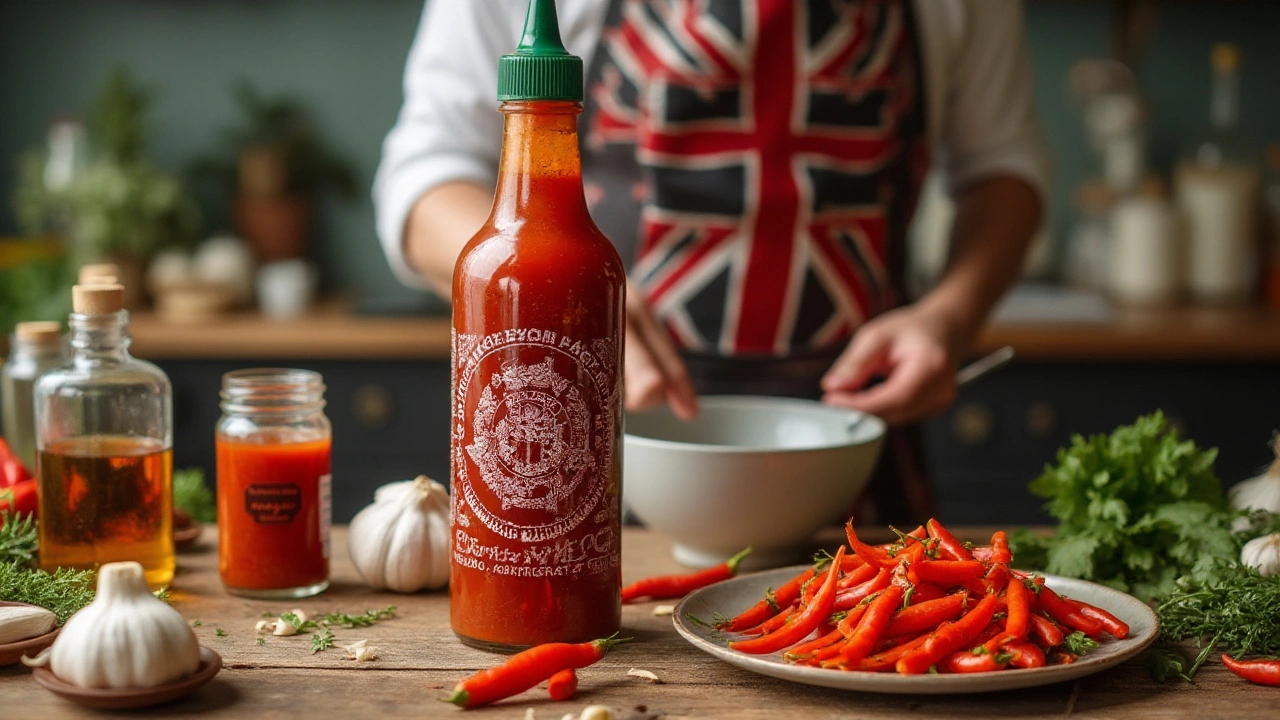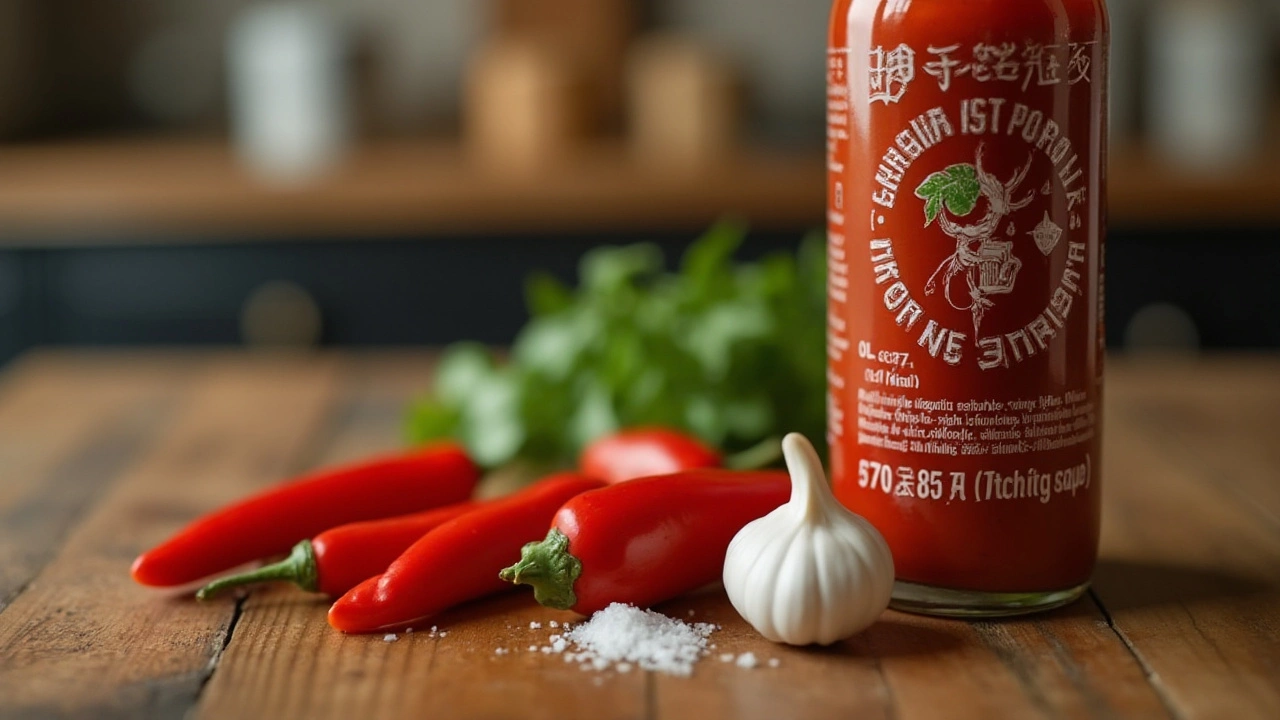Sriracha is a fiery, tangy sauce that has captured the hearts and taste buds of spice enthusiasts around the globe. Known for its versatile use across countless dishes, it frequently graces the tables of vegan kitchens. Yet, its status as a vegan-friendly condiment is a topic of debate among plant-based eaters.
At first glance, Sriracha appears to be a simple blend of chili peppers, vinegar, and garlic. However, a deeper investigation reveals that some brands may include ingredients that don't align with vegan principles. For those dedicated to maintaining a plant-based diet, understanding these nuances is key.
If you're a vegan trying to navigate the world of spicy condiments, this exploration into Sriracha will shed light on what to look out for. From animal-derived components to the chemical mysteries of flavorings, you'll discover how to enjoy this iconic sauce without compromise. Whether you make your own or seek out alternatives, rest assured there's a spicy solution out there for you.
- Understanding Sriracha's Composition
- Animal-Derived Ingredients Explained
- Controversial Components in Sriracha
- Making Your Own Vegan Sriracha
- Exploring Vegan-Friendly Alternatives
- Sriracha in Vegan Desserts
Understanding Sriracha's Composition
Many who enjoy this spicy condiment might be surprised to find that the seemingly simple ingredients of Sriracha mask a more complex concoction. The foundation primarily comprises chili peppers, distilled vinegar, garlic, sugar, and salt, creating that iconic flavor profile lauded by spice lovers worldwide. Yet, each component's role contributes uniquely to both its taste and potential issues for those seeking vegan options.
The heart of major Sriracha brands lies in the use of red jalapeño peppers, which balance heat with a touch of sweetness, making them accessible to a broader range of palates. Vinegar is crucial not only in preserving the sauce but also in enhancing its tanginess, accentuating the flavors while maintaining shelf stability. Garlic lends its pungency, marrying perfectly with the other ingredients to form a fragrant piquancy.
However, sugar in Sriracha presents a sticking point for strict vegans, as the method of sugar refinement can involve animal bone char—a filtering agent creating a bright white product. This poses a dilemma, as not all manufacturers disclose their specific sugar processing methods. It's possible to encounter bone char in the supply chain, which leads some vegans to steer clear or seek certifications to ensure the sugar's vegan status.
Processed ingredients alongside preservatives and stabilizers are also present in many versions of Sriracha, used to maintain its consistency and color over time. Some may include modified food starches or sulfites, both controversial among clean-eating proponents. Recognizing these additives and understanding their sources is essential for anyone keen on consuming strictly plant-based foods.
A spokesperson for Huy Fong Foods, often referred to as the king of Sriracha brands, once remarked, "We strive to make our recipe simple yet delicious," though they stop short of confirming it as 100% vegan. Packaging often does not tell the full story, leaving those with dietary restrictions in a challenging position. Ingredient transparency remains an essential factor for ethically minded consumers.
Given the complexities surrounding ingredient sourcing and processing, those wishing to include this famous sauce in their vegan diet find themselves faced with several choices. One option includes making homemade Sriracha using guaranteed vegan ingredients while exerting greater control over the sauce's sweetness, spice level, and consistency. These custom options ensure that nothing sacrificed in taste or ethics, allowing you to savor the bold flavor of this beloved sauce without worry.
Animal-Derived Ingredients Explained
To uncover why some Sriracha sauces are not vegan, it's crucial to examine the intricate components that may contain animal derivatives. While the basic recipe of most hot sauces centers around chili peppers, vinegar, garlic, and a variety of seasonings, certain additives introduce complexities that challenge the vegan label. Factor in the process of fermentation and preservation, and you heighten the chances of non-vegan ingredients slipping into the mix. For instance, fish sauce is a common flavor enhancer in Asian cuisine that sometimes sneaks into hot sauces to provide umami richness. This potent ingredient is undoubtedly off-limits for those following a plant-based diet.
"Identifying hidden animal-derived ingredients is a common hurdle for vegans. Often, they are listed under innocuous-sounding names," shares culinary expert Linda Stevens, known for her work on preserving culinary authenticity.Apart from explicit additions like fish sauce, there stands the enigmatic 'natural flavors.' These do not always stem from purely botanical sources. In North America, labeling regulations allow for significant latitude; therefore, it's permissible for some of these natural flavors to be derived from animal substances. Although only a small fraction potentially derives from animals, stark vigilance is necessary. In Sriracha and other condiments, these might be minor fractions, but their presence is relevant to vegans.
A less obvious ingredient is sugar. While sugar itself is plant-based, the issue arises with its processing method—a practice potentially involving bone char, an animal-derived charcoal used to whiten sugar. This presents a particular dilemma considering the prevalence of sugar as a balancing component in many sauces, Sriracha included. Then, there’s fish-derived anchovy paste, another occasional troublemaker in various flavor profiles of Sriracha, designed to harmonize sharp acidity with savory undertones. Such potential ingredients if not conspicuous on the label's surface require deeper vigilance from devoted vegan consumers who meticulously scan and sometimes reach out to manufacturers for clarity on what each batch contains.
Beyond these elements, one should also be mindful of preservatives used in extending shelf life. Plant-based diners are often cautious of lecithin, which can be derived from eggs, another unsuspecting addition that could complicate the search for that perfect bottle of Sriracha which adheres to their dietary restrictions. While lecithin from soy is widely used, the possibility of a cross-switch to animal sources lingers without transparency assurances on product labels. The maze of understanding hot sauce ingredients opens up a broader conversation about labeling. Worldwide, transparency remains uneven. Each nation has its provisions, but not all lean equally toward detailed disclosure.
For true peace of mind, choosing a Sriracha certified as vegan by entities like the Vegan Society or opting to make one's own homemade version permits full control over what enters the bottle. As alternatives blossom entering 2025, mindful selections can satisfy cravings while adhering to ethical culinary choices, effectively bridging the gap without sacrificing that beloved spicy note.

Controversial Components in Sriracha
The distinctive flavor of Sriracha sauce has made it a staple in kitchens worldwide, but its ingredients list is not as straightforward as it seems. One primary component that stirs vegan concerns is sugar. It might surprise some people to know that the process of refining sugar often involves using bone char, a substance derived from animal bones. Bone char is a material used by some sugar producers to achieve the desired white color of sugar crystals. Because of this, sugar in Sriracha may be objectionable to vegans who avoid animal products completely.
Another ingredient that raises eyebrows is the natural flavors listed on many Sriracha bottles. This vague term is often a catch-all phrase for a variety of components that could include animal-derived substances. The lack of transparency around these ingredients leaves consumers questioning whether their beloved spicy sauce aligns with their dietary choices. According to Food and Drug Administration guidelines, the specifics of natural flavors aren't required on labels, which can complicate decision-making for those adhering to strict vegan diets.
"Understanding food labels can be challenging, especially with products as beloved as Sriracha. Consumers are right to question what natural flavors entail," says Dr. Amelia Greene, a food scientist at the Culinary Institute.
It's important to note that not all Sriracha brands are created equal. Some manufacturers are more forthcoming about the sources of their ingredients, helping those following a vegan diet make more informed choices. For instance, some brands may distinctly label their products as vegan, ensuring that no animal-derived ingredients are used. If you’re committed to a vegan lifestyle, seeking out these specific brands can alleviate concerns over hidden animal products in your hot sauce.
Besides the primary ingredients, the preservatives in Sriracha are worth scrutinizing. While these additives maintain the sauce's longevity, they may also be sourced from animal by-products. Vegan-friendly brands often use organic or plant-derived preservatives, making them a safer choice for those pursuing a plant-based diet. For anyone deeply invested in veganism, scrutinizing labels and understanding potential red flags in condiment ingredients could help avoid inadvertently consuming animal derivatives.
One fascinating aspect of the Sriracha saga is the varied recipe adaptations you can find today. In the quest to solve these controversies, some passionate food enthusiasts and entrepreneurs have taken it upon themselves to create homemade versions of the beloved sauce. These versions typically start with fresh chili peppers and garlic but replace sweeteners, preservatives, and any suspect flavorings with certified vegan alternatives. This movement not only addresses vegan concerns but invites a creative exploration of flavors, as folks incorporate diverse herbs and spices into their personal concoctions.
Making Your Own Vegan Sriracha
Creating your own vegan version of this iconic sauce is not only possible, but it's incredibly rewarding. When you prepare homemade Sriracha, you have complete control over the ingredients, ensuring everything aligns with your dietary preferences. The process is straightforward and can be a fun kitchen experiment that results in a customized flavor profile suited perfectly to your taste. Most homemade vegan Sriracha recipes focus on natural, plant-based ingredients that bypass the concerns of fish sauce or sugar processed with bone char often found in commercial versions.
To get started, you'll need fresh red chili peppers, which form the base of the sauce. Choose peppers that are vibrant and firm to add a robust, fiery base flavor. Garlic is another essential component, lending an aromatic depth to the spiciness. For the tangy aspect, distilled vinegar is preferred, as its sharpness balances out the natural sweetness of the peppers. A touch of sweetness is crucial in creating a well-rounded Sriracha; consider using maple syrup or agave nectar as sweeteners, both of which are reliable vegan options. A bit of salt is necessary to bring out the flavors, and you might add a hint of umami by including miso or tamari as alternatives to fish sauce.
Follow these steps to craft your own version of vegan Sriracha:
- Start by washing and chopping 2 pounds of fresh red chili peppers and 8 cloves of garlic. Remove the seeds to adjust the heat level, depending on your preference.
- In a blender, combine the chopped peppers, garlic, 1 cup of distilled vinegar, 3 tablespoons of maple syrup, and 2 teaspoons of salt. Blend until you achieve a smooth consistency.
- Transfer the mixture into a sterile glass jar. Cover it loosely and allow it to ferment at room temperature for three to five days, stirring daily to release gases.
- After fermentation, pour the mixture back into the blender and blend again for a smoother texture. If desired, strain it to remove large bits for a fine sauce consistency.
- Heat the mixture in a saucepan over medium heat and bring it to a simmer for about 5 to 10 minutes. This step helps enhance the flavors and ensures preservation.
- Let it cool and transfer your homemade Sriracha into glass bottles. Store it in the refrigerator, where it can last for several months.
Homemade Sriracha not only guarantees that all components are plant-based, but it also allows for creative variations. Consider adding ingredients like ginger for an additional layer of flavor or experimenting with different types of peppers to discover new heat profiles. Remember, making your own Sriracha is not just about having a vegan twist on a traditional item; it’s a proactive step towards mindful eating. According to renowned chef Yotam Ottolenghi, "Cooking is about using your senses, whether creating a traditional dish or inventing something entirely new."

Exploring Vegan-Friendly Alternatives
In the quest for a vegan-friendly spicy condiment, the vibrant world of plant-based alternatives opens up a realm of delightful possibilities. While some Sriracha brands might not align with a strict vegan diet, a number of spice-laden friends are ready to step in and light up your taste experience without compromising on principles. These substitutes not only mimic the beloved Sriracha's iconic heat but often bring additional flavor profiles to the table, accommodating broader culinary adventures.
First on the list is the accessible chili paste. Often found in various Asian markets, these pastes are the backbone of many flavorful dishes, offering a fiery kick minus the questionable ingredients. Something as simple as sambal oelek, a fiery red paste of ground raw chili peppers and salt, can serve as an excellent substitute. It's as versatile as it is simple, allowing you to amp up your average stir-fry or perk up a steaming bowl of rice noodles. A quick survey of the ingredient list, though, is critical to ensure no shrimp paste or fish sauce slips in unnoticed.
For those who crave that classic Sriracha tang, crafting your own Sriracha at home can be quite rewarding. This not only grants full control over what goes into your batch but also lets you tweak the spice level and flavor notes according to your personal palate. Start by blending fresh red jalapeños with garlic, vinegar, and a sweetener of your choice, whether it be coconut sugar or maple syrup, for a vegan edge. A touch of salt and time to ferment transform this blend into a luscious sauce embodying homemade goodness.
Some well-known commercial brands also cater to the vegan crowd, producing versions devoid of animal traces. Do a bit of sleuthing during your next grocery run, and you may uncover gems like Yellowbird's organic Sriracha which boasts a clean label and no artificial additives. Even brands like Tabasco have ventured into more varied pepper sauces, with green pepper sauce often serving as a sizzling companion to Sriracha fans. These brands often pride themselves on transparency and provide comprehensive ingredient lists that bear the friendly assurance of being vegan-approved.
Another option worth a mention are smoked paprika-based sauces, which open the door to a smoky backdrop combined with that sought-after heat. By mixing smoked paprika with apple cider vinegar and a dash of cayenne pepper, you create a unique twist on the Sriracha theme that pairs well with plant-based proteins like tofu or tempeh. Even roasted red bell peppers can be puréed into a smooth consistency with some garlic and vinegar, an excellent option for a milder yet fruity zing.
The exploration of these alternatives not only widens our understanding of what the spicy condiment world has to offer but also reinforces the beauty of a plant-based lifestyle that doesn't miss out on any iconic flavors. Often, the pursuit of options is guided by a strong desire to align dietary habits with ethical values, a pathway warmly embraced by the growing community of vegan spice lovers. As John Robbins once said,
The simple act of living and eating consciously can turn us into a more compassionate individual.And what better way to start than by savouring every spicy bite responsible and green?
Sriracha in Vegan Desserts
In the culinary world, innovation knows no bounds. Enter Sriracha, the spicy sauce that is making a surprising debut in vegan desserts. This flavor combination might seem unconventional at first, but the sweet heat of Sriracha can introduce a daring twist to traditional desserts, transforming them into exciting treats that captivate the palate. A dollop of this spicy condiment in your dessert can add a layer of complexity, contrasting and enhancing the natural sweetness of plant-based ingredients like coconut milk and dark chocolate.
One popular approach is to incorporate Sriracha into vegan chocolate desserts. The pairing of dark chocolate and chili is nothing new—cultures have explored this enticing blend for centuries, dating back to the ancient Maya and Aztec. By adding Sriracha to a rich vegan chocolate mousse or a creamy pudding, you can elevate the dessert to a gourmet experience. The spice teases the depth of the chocolate, offering flavor notes that are both unexpected and delightful. For those with an adventurous palate, crafting a batch of vegan Sriracha chocolate truffles can be a rewarding kitchen experiment.
Sriracha isn't limited to just chocolate-based concoctions. It can also shine in fruity desserts. Imagine a mango sorbet with a kick of Sriracha sauce. The heat from the Sriracha perfectly balances the tropical sweetness, creating a refreshing dessert with a hint of spice. Likewise, a vegan pineapple upside-down cake can benefit from a touch of Sriracha in the caramel glaze. This application gives a surprisingly addictive twist, leaving your guests guessing what the secret ingredient could be.
Creators in the kitchen understand that the use of Sriracha in vegan desserts requires a delicate hand. Balance is key to achieving a harmonious flavor profile. Too much heat can overwhelm, but just the right amount can create an unforgettable taste sensation. As noted by culinary experts, the best way to introduce Sriracha is gradually. Experiment with small increments, tasting as you go to ensure the desired balance.
In an inspiring chat, renowned culinary artist Emma White once commented,
"Spice in dessert isn't just about heat; it's about awakening the taste buds in a way that's unexpected and intriguing. The right hint of Sriracha can deliver an entirely new dimension to the dessert experience while still respecting the classic sweet profiles."Her guidance is a testament to the potential that Sriracha holds when incorporated with mindfulness and creativity.
For those keen on trying their hand at vegan desserts with Sriracha, start simple. Integrate the sauce into frostings or creamy fillings, experiment with drizzle over fruit tarts, or combine it in a sauce for dipping delicate and sweet vegan pastries. This playful exploration can unveil delightful surprises that embody the perfect blend of sweet and spicy. It's recommended to keep tasting notes on what works well and adjust according to personal taste preferences. Use Sriracha's potential to excite, surprise, and engage the taste buds, making your vegan creations truly stand out.





